
CHAPTER 6
RUM
RECIPES

Rum stands alone among distilled spirits when it comes to cooking. Rum partakes of the sweet, the fragrant, the harsh, the smooth, and the dry. You can evoke fire or sunshine. The presence of rum as an ingredient in food is so intense that it can be considered as important as the power of rum as a drink.
For many of us, there’s no purer rum dessert than the magnificent and excessive baba au rhum. It’s a yeast-raised spongy cake that’s soaked—I mean saturated—in sweetened rum. It’s eaten wetly with a fork or a spoon and the rich caramel/vanilla and penetrating nose of the spirit provides the flavor spike that enlivens the cake. Most rum-based dishes rely on the same trick: caramel and vanilla are great friends of sweetness, throw ’em together and you can’t go wrong.
There’s another contribution that rum can make in the kitchen and that’s in the earthy edge it gives to meats and stews. If you have a dish to which you could conceivably add maple syrup, brown sugar, or any sweetened sauce, it could probably benefit from a touch of rum.
When in Doubt, Flambé
Once upon a time, before cities like Philadelphia, Madrid, and San Francisco became the centers of ambitious, delicious food, the world looked meekly to Paris and Lyons for the techniques and recipes that excited the imagination if not the palate. One of the most dramatic techniques was the relatively simple matter of dousing a food with a high-proof alcohol and setting it on fire.
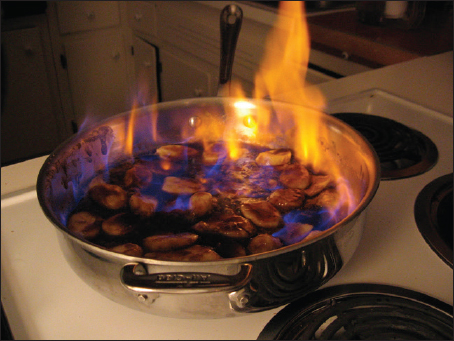
Rum is a good fuel for flambé as in this Bananas Foster. Photo by Jenene Chesbrough.
The (presumably fakelore) story of its origin has a waiter in nineteenth century Monte Carlo accidently setting fire to a dish of booze-soaked crêpes that were about to be served to a visiting princeling. The flustered waiter named the dish after the fellow’s companion and thus Crêpes Suzette were born.
In America, this dish survived as an expensive prom night/seduction dinner/proposal of marriage flourish that was said to cause an entire dining room to turn its head and gasp in admiration at its sheer grandeur and profligacy. Restaurants of a certain haute bourgeois type always kept this dish or its cousin Cherries Jubilee on the menu. More ambitious places may have added the word “flambé” to a dessert item and doubled its price, thereby increasing both check size and tips for the waiter or maître d’.
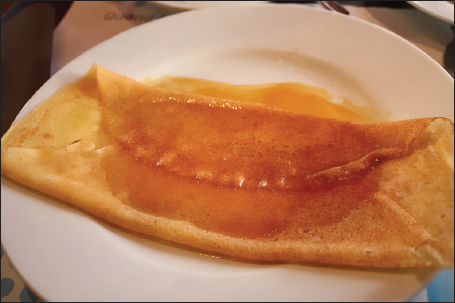
Photo by Javier Lastras.
No dessert is spiced with such romance it invites the diner to a dance, to eat, to gorge to take a chance to madly throw off shirt and pants.
There's passion hid in just the name there's hints of riches, sex and fame and so, alas, it's such a shame, they're only flapjacks set aflame.
A Word of Caution
Setting things on fire in your dining room is a bad idea. Don’t do it. If in spite of this good advice, you decide to put a match to a flammable liquid inside a building, well . . . you’ve been warned.
How to Flambé
Simply pouring Sterno on food and setting it afire is not flambéing. What you need is a sauce that combines alcohol, sugar, and water. Burning the alcohol changes the character of the sauce by caramelizing the sugar, removing the harsh flavor of raw alcohol, and leaving behind whatever essence the alcohol carried with it. Thus, flambéed rum leaves the tang of burnt sugar and the spiciness of the rum. Flambéed gin leaves the hint of juniper and angelica, and bourbon gives you caramel and oak.
Some recipes recommend flambéing with 151 proof rum or higher. Aside from being relatively low in residual flavor, these spirits are highly flammable and are a bad thing to have anywhere near an open flame. Rum, at 80 to 100 proof and diluted with other ingredients, is ideal.
The rum must be heated before lighting it on fire. This makes it much less likely to ignite when you don’t want it to. What happens is that since alcohol has a lower boiling point than water, as you heat the mixture, the fumes of evaporating alcohol rise first. When you bring your long fireplace match close to the mixture, what ignites are the vapors above the sauce. The flame is pale and blue and in the old days, the lights were usually lowered to both dramatize and emphasize the fiery moment. Cinnamon and clove, both of which are of an oily nature, are sometimes added not only for flavor, but for show as the powder ignites when added.
So here we go. Let’s start with a pan on the stove, some butter and some bananas.
Bananas Adler, pioneered by the famous physician-gourmet Dr. Joan Adler
1 ounce (25 g) butter
2 tablespoons brown sugar
1 banana peeled, halved, and cut lengthwise
2 ounces (50 ml) dark rum
Vanilla ice cream
Lady fingers or homemade genoise
On a small plate, arrange the lady fingers to form a square. Scoop vanilla ice cream in the center of the square. In a small skillet, melt the butter. Use a wooden spoon so you don’t burn your fingers later on when things get hot. Add the brown sugar and stir. Add the banana and cook until browned (caramelized) on both sides, over medium-high heat. Move pan off heat, add the rum and stir. Return to the stove and either tilt the pan to catch a bit of flame or use a long fireplace match to set the vapors on fire. Stand back when ignited and let the bananas brown. When the flame dies the alcohol has been cooked out. Serve bananas over vanilla ice cream and/or a slice of pound cake.
Cherries Jubilee
1 pint vanilla ice cream
1 pound (500 g) cherries, stemmed and pitted
½ cup (100 g) sugar
1 lemon
½ cup (100 ml) brown rum
The rich, complex cherry sauce will merge beautifully into a very creamy French-style vanilla ice cream or gelato. Unfortunately, it will also make a cheap, gummy ice cream seem cheaper. Choose with the angels.
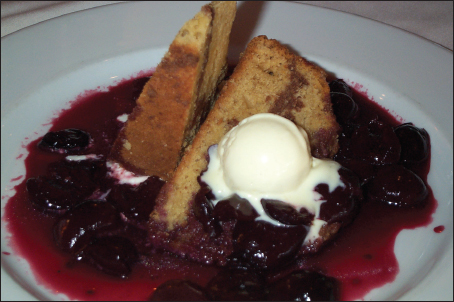
Cherries Jubilee, a once-popular dessert, may be due for a comeback. Photo by Stu Spivack.
Scoop the ice cream into four dishes or decorative glasses and put in the freezer until ready to serve (this can be done up to four hours ahead).
Wash and pit the cherries. Put the cherries and sugar in a large skillet. Peel 2 strips of zest from the lemon in wide strips with a peeler and add to the cherries. Squeeze the juice of half the lemon over the top. Stir to combine evenly. Cover and cook the cherries over medium-low heat until the sugar dissolves, about 4 minutes. Uncover and cook over medium-high until cherries get juicy, about 5 minutes more.
To flambé the rum: If cooking over a gas flame, pull the pan off the heat and add the rum. Ignite the alcohol with a long match or one held with tongs. Swirl the pan slightly until the flames subside, about 30 seconds.
Wait a minute or two. Some authorities recommend a waiting period to give the cherries time to think about themselves and get ready for their big moment. Others feel that the slightly cooled cherries are less likely to crack the now-frozen glasses. After an appropriate waiting period, ladle the cherries and their juices over prepared ice cream scoops. Serve immediately.
What does all this pyromania do to the taste? There is some dispute here and that’s remarkable considering how much drama is involved. Some chefs deride the whole business as sheer showmanship, others say that there is a subtle difference, and a third group maintains that the showmanship is the point. (Could you ever forget a dinner that ended with a flaming rum-soaked slice of pound cake being extinguished by a gush of whipped cream?)
Savory Dishes
Francis Hogan, executive chef at Bluestem Brasserie, San Francisco and member of the Butchers’ Guild was recently honored at the James Beard House in New York. Here’s his take on rum and grilled meat.
Rum Marinated Rib Eye Steak
4 (12 ounce) rib eye steaks
13 ounces white rum
6.5 ounces extra virgin olive oil
1/3 cup brown sugar
1 tablespoon Sriracha
2 tablespoons strong Dijon mustard
2 tablespoons kosher salt
Combine everything except the steak and whisk until sugar and salt dissolve.
Place steaks in a Ziploc bag and pour marinade over.
Marinate for 24 hours, turning the bag once.
Remove the steaks from the bag. Allow excess marinade to drip off.
Season the steaks with salt and pepper and cook as desired.
Serve with chimichurri.
Chimichurri:
1 bunch Italian parsley, chopped
6 garlic cloves, minced
¾ cup extra virgin olive oil
¼ cup red wine vinegar
2 tablespoons fresh lemon juice
½ teaspoon red pepper flakes
2 teaspoons kosher salt
1 teaspoon black pepper
Stir all ingredients to combine.
Notice that Chef Hogan doesn’t say what to do with the marinade. What you’ve got left is a bit under a pint of a sweet, sour, oily, hot, salty liquid. Chilled and covered, it will keep almost indefinitely. What can you use it for? (You’ll probably want to boil the marinade to ensure that it’s bacteria-free.) Here are three suggestions:
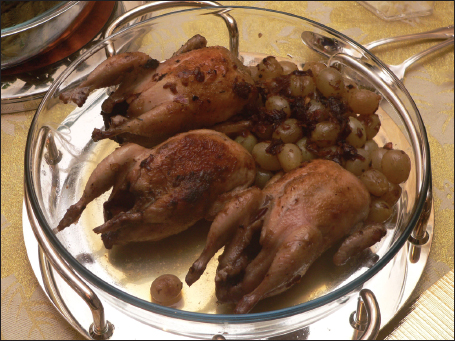
Roasted quail in rum glaze. Copyright © 2006 David Monniaux.
Deglazing
Every good cook should know this: When you brown meat, vegetables, or fish in a very hot pan, you get two products. You get the browned food itself and also its footprint, bits of brown that stick to the pan. These brownings are the most thoroughly transformed, caramelized essences of the food itself and it’s a pity to rinse them down the drain when you wash the pan. Instead, lower the heat and add some liquid, stirring to dissolve the brownings. If you use a flavorful liquid like wine or beer, you’re on your way to a light, simple sauce. Add a bit of vinegar to the wine and you have the elegant, lively accent called a gastrique. Or you can add a bit of Hogan’s Marinade and have a wonderfully complex sauce that complements a range of meats and fishes. If you think of the appeal of barbecue, you’ve got it. Sifting a bit of ultra-fine flour into the liquid as it heats in the pan gives you a thicker sauce. Adding rum, allowing it to begin to vaporize and then setting the vapors on fire is a savory extension of the flambé technique we discussed earlier.
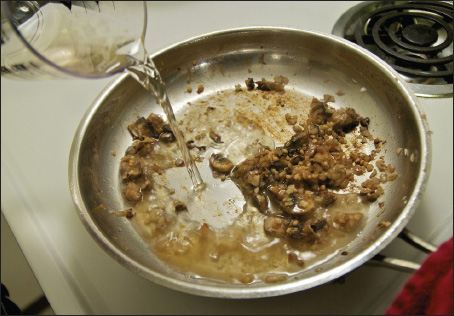
The simplest sauce.
Salad or Vegetable Dressing
Salad greens and most vegetables rely on a simple flavor or two and a crisp texture for their appeal. You can add layers of complexity by dressing the veggies or greens with a simple dressing based on the leftover Hogan’s Marinade. It’s pretty simple to separate a yolk from its egg and put it, along with a cup of marinade, in a straight-sided cup or jar. If you have a stick blender, use it to whip the mixture. The egg will act as an emulsifier, uniting the oil and the rum into a dressing that won’t separate.
You can cheat a bit and use commercial mayonnaise—perhaps two tablespoons in lieu of the egg.
As a Seasoning in Soup or Stew
The dishes that benefit from this are hearty, thickly textured, or strongly flavored. For a soup, you can use Hogan’s Marinade in proportions up to about one to ten. That is, for every ten ounces of soup, try an ounce of marinade.
For a stew:
• let the marinade stand until a layer of oil has separated and risen to the top of the container. Pour a few tablespoons of oil into the hot pan.
• brown some beef, pork, or lamb cubes that you’ve coated in flour, salt, and pepper and transfer to a slow-cooker.
• brown a chopped up onion and some pieces of potato or carrot, adding more oil if necessary. Put them in the slow cooker and add some celery and a handful of fresh chopped herb.
• pour the reserved Hogan’s Marinade over the food, cover, and cook on High until desired tenderness is achieved.
You can make a fishy variation on this by browning and slow cooking everything but the meat. When the starchy vegetables are soft, put some chunks of salmon that you’ve seared in a bowl and cover with the expanded Marinade.
Fish
Rum Cedar-Planked Salmon
Be sure to use cedar that hasn’t been treated with chemicals. It’s best to inquire carefully at the lumber yard, buy directly from a mill, or spend the extra money on cedar planks at the kitchen supply store.
You can scale this recipe, but it’s especially appealing if you present an entire side of salmon on a single plank. Two details: first, always soak any plank, cedar or otherwise, that you’re going to put near fire or the wood will go up in flames. Second, be sure to dilute the rum as instructed or the wood will go up in flames. Finally, don’t sit on the grill or you will go up in flames.
Salmon filet, skin-on
Cedar planks soaked in five parts water to one part dark rum.
Seasoning rub
Sugar and salt, equal parts
White pepper
Coriander seed
Chopped rosemary
Moisten with enough lemon juice to make a paste
Preheat the grill to a medium low heat (275°F). Put the fish—with pin bones removed—on the plank and cover the flesh side of the filet(s) with the seasoning rub and refrigerate loosely covered for at least half an hour. Cook until the fish is slightly firm to the touch.
The same recipe can be prepared in a smoker, adding the rum to the seasoning rub and adjusting the time accordingly.
Rum-Cured Salmon
If all that smoke and flame is a little too much for your one-bedroom apartment, you can get an elegant appetizer with the same palate of flavor.
Place the salmon filet—again with pin bones removed—on a dish. Make up enough of the same rub to cover the fish and smear it on. Cover with plastic wrap and then add another plate and a pound or more of weight (a half gallon jug filled with water or milk is just right).
In 12 to 30 hours, scrape off the rub and slice the fish thinly on the diagonal. Sprinkle the slices with capers and chopped hardboiled egg, and graciously accept ooohs and aaahs from your guests.
Rum at the Barbecue
There’s a master recipe here and it goes something like this: you marinate meat in a mixture of rum, spices, sugar, salt, and acid. Remove the meat, pat it dry, and grill it. While the meat is improving itself on the grill, boil the marinade until its volume is reduced by half. Spread the thickened marinade (now a sauce) on the meat and serve. Here’s an example, but I’m sure you can come up with more.
½ cup (100 ml) dark rum
2 tablespoons (30 ml) lime or lemon juice
2 tablespoons (30 ml) soy sauce
2 tablespoons (30 g) brown sugar
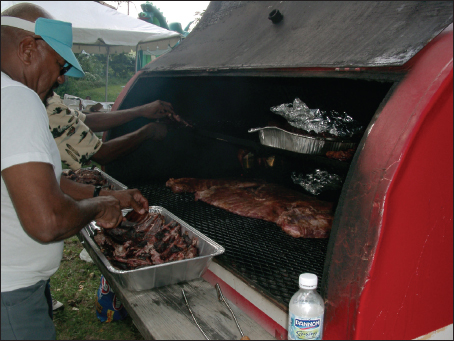
Kansas City barbecue. Photo by Jeffrey J. Martin.
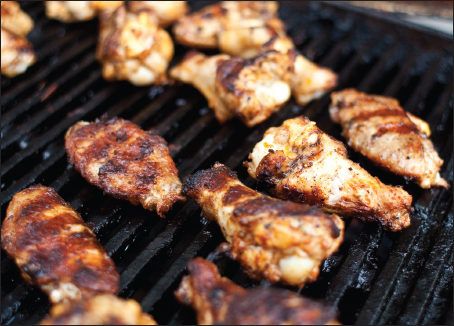
Not all wings are from Buffalo. Photo by Flickr user Taz.
4 cloves garlic, minced
1 small jalapeno pepper, seeded and chopped
1 tablespoon (30 ml) grated ginger
1 teaspoon black pepper
3 boneless chicken breasts, halved
Combine rum, lime juice, soy sauce, sugar, garlic, chilies, ginger, and black pepper. Place chicken in resealable food storage bag; pour marinade over chicken. Press air out of bag and seal tightly. Turn bag over to completely coat chicken with marinade. Refrigerate at least 4 hours.
Drain chicken; reserve the marinade. Grill chicken, in skillet or on uncovered grill, until chicken is firm to the touch and no longer pink. While chicken is cooking, boil marinade until it’s reduced by half. Pour the reduced marinade (now a sauce) over the chicken.
Sweet Dishes
The caramel flavor of dark rum makes it a perfect companion to many desserts. Here’s a recipe for one of the simplest and most elegant:
Sweet Rum Sauce
Here’s a general purpose dessert sauce that enables you to link the flavors of the rum palate to a whole universe of desserts. Quantities are provided, but this scales up to the safe maximum of your pan or down to a spoonful.
2 tablespoons (25 g) butter
2 tablespoons (25 g) white or brown sugar
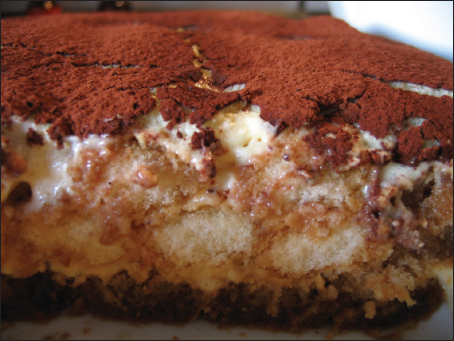
Tiramisu: rum and coffee-soaked lady fingers with whipped cream and mascarpone in this seductive Italian classic. Photo by Sebastian Kügler.
8 ounces (225 ml) cream or half and half
2 ounces (50 ml) rum
½ teaspoon vanilla
Cook the sugar in the butter over medium-high flame until sugar is fragrant.
Add cream, lower heat, and reduce the sauce slightly.
Add rum and vanilla and simmer until reduced by about half.
This recipe can also be used to make a savory sauce. Omit the vanilla at the end and include a half teaspoon of black pepper in the first step. Both the sweet and savory versions should be quite dark.
Rum Sabayon
Jonathan Deutsch, PhD
Drexel University Center for Hospitality and Sport Management
Many sweet dishes like babas au rhum use rum as a flavorful and boozy soak to bracing effect. Artusi himself suggested the addition of rum to the classic marsala or madera, but rum alone is akin to tasting the rum swirled in a warm creamy snifter. You’ll never want to return to the traditional.
Serve over tropical fruit and genoise. Or just about anything else.
Serves 4
4 egg yolks
Zest of half a lime
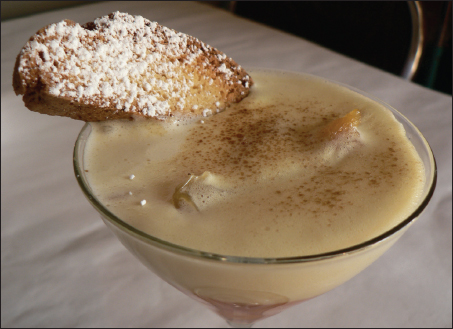
Sabayon. Photo by Stu Spivack.
One squeeze fresh lime juice
1–1 ½ ounce shot rum
⅓ cup sugar
Splash water
Combine all ingredients in a medium stainless steel bowl or the top of a double boiler. Cook over simmering water, whisking constantly, until it thickens to the texture of melted ice cream. If you get scrambled eggs you’ve become too hot and gone too far. Start over. You’ll get it the second time. Adjust lime juice and sugar to taste.
Rum Custard
Jon Deutsch’s Sabayon (Zabaglione) above is probably the king of all dessert sauces. If you’re at all intimidated by the “whisk over hot water don’t let it curdle” part, here’s a universal rum custard recipe.
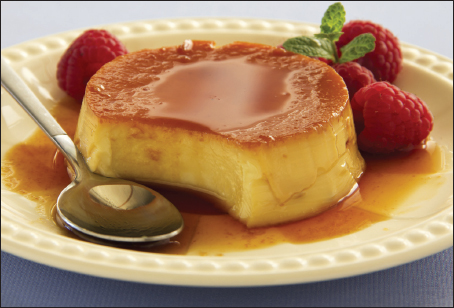
The usual proportions for a sweet custard are one egg and two tablespoons of sugar for each cup (225 ml) of milk. You can also use half and half or even light cream for a richer custard. An egg to a cup of liquid is the minimum proportion of eggs to milk which will produce properly thickened custard. You may, though, use as many as four eggs and increase the sugar to four tablespoons. Increasing the sugar will make the custard less firm and lengthen the cooking time. Increasing the egg will make the custard firmer and shorten the cooking time.
When you play with this recipe, if you feel you’re not getting enough fat, you can also substitute two egg yolks for one whole egg.
3 cups (675 ml) milk or half and half
4 eggs
½ cup (100 g) sugar
1 to 3 tablespoons dark rum (15–45 ml)
½ teaspoon salt (3–4g)
Additional flavoring: nutmeg, cinnamon, allspice
Preheat oven to 350°F/175°C.
Mix milk and well-beaten eggs with sugar, rum, and salt.
Place six to eight baking cups in a pan large enough to hold the cups without them touching the side of the pan or each other. Pour mixture into the cups, sprinkle with ground spice.
Put the pan in the oven and pour very hot water to almost the top of the baking cups. Bake until a knife inserted in the center of the custard comes out clean, maybe 25 to 30 minutes. Remove cups from water bath and cool for 15 minutes. You can cool these custards and top them with fruit or whipped cream, but they will never taste better than they do while they are still just slightly warm.
By the way, if you find yourself enchanted by any of the rum cocktails in chapter 7, you can nudge the flavor of the custard in that direction. Mojito custard? Just crush some mint and lime peel in rum and let it sit for half an hour before you add it in. If you like the combination of coffee and rum, use about ¾ cup (80 g) of whole coffee beans and pour your milk/cream mixture (about a cup and a half—300 g) over it. Allow the mixture to infuse overnight in the refrigerator and then proceed with your custard recipe. Dark roast coffee works best.

A few enthusiasts insist on molasses as a baking ingredient. Photo by Gaetan Lee.